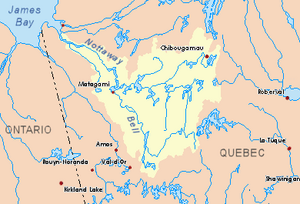Irene River (Opawica River tributary) facts for kids
Quick facts for kids Irène |
|
|---|---|

Watershed of Nottaway River
|
|
| Country | Canada |
| Province | Quebec |
| Region | Nord-du-Québec |
| Physical characteristics | |
| Main source | Trois Îles Lake Eeyou Istchee James Bay (municipality), Nord-du-Québec, Quebec 378 m (1,240 ft) 49°31′36″N 74°37′47″W / 49.52667°N 74.62972°W |
| River mouth | Opawica River Eeyou Istchee James Bay (municipality), Nord-du-Québec, Quebec 349 m (1,145 ft) 49°32′39″N 74°50′10″W / 49.54417°N 74.83611°W |
| Length | 47.8 km (29.7 mi) |
| Basin features | |
| Tributaries |
|
The Irene River is a river in Quebec, Canada. It flows into the Opawica River. This river is located in the Nord-du-Québec region. It flows through the area known as Jamésie.
The Irene River crosses the areas of Fancamp and Rasles. The main activity here is forestry, which means cutting down trees. Tourism, like fishing or camping, is also important. Forest roads help people get around the southern part of the river valley. The river usually freezes from early November to mid-May. It is generally safe to travel on the ice from mid-November to mid-April.
Contents
Where the Irene River Flows
The Irene River is surrounded by many other lakes and rivers. To the north, you can find Eau Jaune Lake and the Obatogamau River. East of the Irene River are the Obatogamau Lakes. To the south, there's Des Vents Lake (Opawica River) and Caopatina Lake. West of the river, you'll find Bras Coupé Lake and the Yvonne River.
River's Beginning
The Irene River starts at Trois Îles Lake (which means "Three Islands Lake"). This lake is about 1.8 kilometres (1.1 mi) long. It sits at an elevation of 378 metres (1,240 ft) (about 1,240 feet). This starting point is in the Fancamp area.
From its source, the Irene River flows for about 47.8 kilometres (29.7 mi) (about 30 miles).
The River's Journey
The river's journey can be split into two main parts:
Upper Part of the River
The upper part of the Irene River is about 33.1 kilometres (20.6 mi) long.
- It flows southwest for 5.6 kilometres (3.5 mi) to Winchester Lake. The river then goes through Winchester Lake for 2.6 kilometres (1.6 mi).
- Next, it flows west for 3.1 kilometres (1.9 mi) towards a forest road.
- It then turns northeast for 5.0 kilometres (3.1 mi) to an unnamed lake.
- The river winds southwest for 6.1 kilometres (3.8 mi) to a bay in Irene Lake.
- Finally, it flows north for 5.5 kilometres (3.4 mi), going around a peninsula. It passes through Irene Lake, which is about 7.8 kilometres (4.8 mi) long.
Lower Part of the River
The lower part of the Irene River is about 14.7 kilometres (9.1 mi) long.
- It flows north for 2.9 kilometres (1.8 mi) to a bend in the river.
- Then, it goes west for 3.8 kilometres (2.4 mi) to the eastern shore of Opawika Lake.
- The river crosses Opawika Lake for 2.5 kilometres (1.6 mi). This lake is about 3.1 kilometres (1.9 mi) long.
- The final 5.5 kilometres (3.4 mi) of the river flows southwest through a marshy area. This is where it reaches its mouth.
Where the River Ends
The Irene River flows into the north bank of the Opawica River. The Opawica River then flows southwest and north. It eventually joins the Chibougamau River. When these two rivers meet, they form the Waswanipi River. The Waswanipi River flows west through several lakes, including Lake Waswanipi, Goéland Lake, and Olga Lake. It then empties into Lake Matagami. Finally, Lake Matagami flows into the Nottaway River, which eventually reaches James Bay.
The spot where the Irene River meets the Opawica River is:
- About 83.0 kilometres (51.6 mi) east of where the Opawica River meets the Chibougamau River.
- About 53.3 kilometres (33.1 mi) southwest of the town of Chibougamau.
- About 27.2 kilometres (16.9 mi) south of the village of Chapais, Quebec.
River's Name
Over time, different Indigenous groups lived in this area. These included the Atikamekw, the Algonquin peoples, and the Cree. The name "Irene" is a French first or last name. The name "Irène River" was officially recognized on December 5, 1968. This was done by the Commission de toponymie du Québec, which names places in Quebec.

